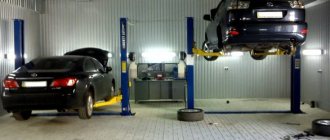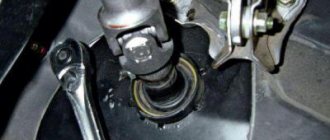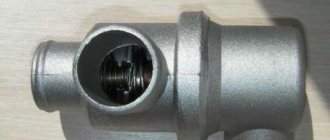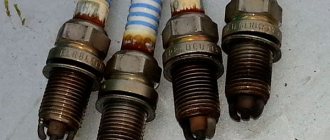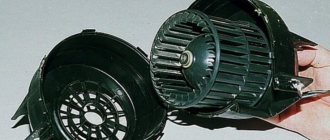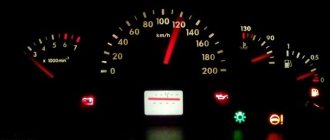A knocking sound when turning the steering wheel indicates problems with the vehicle's steering system. The causes of knocking may be malfunctions of the constant velocity joint (CV joint), ball joint, wear of the steering tip and/or support bearing, stabilizer link and other malfunctions. In any case, when a knock is heard when turning the steering wheel, it is necessary to carry out diagnostics as quickly as possible, since malfunctions of the steering system not only worsen over time, but can also lead to emergency situations when the car is moving, even an accident.
Causes of knocking noise when turning the steering wheel
There are a number of reasons why a knock is heard when turning the steering wheel. To more accurately determine the malfunction, it is necessary to determine three circumstances:
- Sound type. It can be single or repeated, voiceless or voiced (usually metallic), loud or quiet.
- The place from which the sound comes. For example, in the wheel, in the suspension, in the steering wheel.
- Circumstances of occurrence. In particular, when driving, when turning the steering wheel in place, when the steering wheel is turned all the way, when turning left or right.
Based on such data, you can focus on the source of the knocking sound.
| Place of knock | Causes of knocking |
| Knocking in the wheel | Partial failure of the angular velocity joint (the boot is torn, problems with the bearing), noise from tie rods/steering rods, steering rack when driving on rough roads, shock absorber struts (spring knocking), stabilizer struts |
| Rack knock | Damage to the rack shaft, increased play of the bushing and/or shaft bearings, on machines with electric power steering, mechanical damage to the engine shaft and/or worm drive, wear in the steering shaft driveshaft |
| Knocking in the steering wheel | Partial failure of the steering rack, rusting of the rack drive shaft, wear of the worm drive in the EUR and/or mechanical problems with the electric motor |
| Steering wheel position | Causes of knocking |
| When turning the steering wheel all the way (left/right) | When replacing the front control arm, it is possible that the lever hits the subframe when turning. Sometimes craftsmen simply do not fully tighten the fasteners, which cause them to creak when turning. |
| When turning the steering wheel while the car is stationary | Faulty steering rack, universal joint, loose fasteners, tie rods/ends |
| When turning the steering wheel while the car is moving | The same reasons as when the car is stationary, but problems with stabilizer struts and shock absorber struts are added here. |
Below is a list of reasons why knocking occurs when turning in the area of the wheel, suspension and steering wheel, according to the degree of their prevalence.
Self-diagnosis: easy to master
This, of course, does not happen immediately, but with the acquisition of experience, a person with a minimal inclination towards technology can easily identify a number of standard breakdowns of his car. To some extent, the skill of self-diagnosis is also due to the high cost of maintenance, and sometimes to the incompetence of specialized personnel at the service station.
Typically, the ability to correctly identify car breakdowns will be useful to you in any case, regardless of the chosen car brand. First of all, the chassis of the car suffers - most often due to bad roads. We will try to understand the reasons for the rapid wear of the chassis of today's popular brands. We will describe possible options for their breakdowns, learn how to diagnose them based on symptoms (a knock in the steering wheel when turning, for example), and also consider options for quick routine repairs and preventive maintenance of your “iron horses.”
Constant-velocity joint
With the wheels turned completely to one side, the CV joint will most often creak (it may even give impacts to the steering wheel). When turning the car to the left, the right outer CV joint will crunch/knock, and when turning to the right, the left one will, accordingly. Inner CV joints usually creak when driving at high speed on uneven roads, so they have nothing to do with knocking when turning. So if you hear a knocking sound when turning or sharply accelerating your car, the outer joint most likely needs to be replaced. However, first you can remove it and inspect it - if there is no wear or it is small, then CV joint lubrication will help.
Tie rods and tie rods
Due to natural wear and tear, the lugs and rods may, over time, become loose and squeak and make knocking noises when turning the machine. To diagnose the steering tips, you need to jack up the car on the side where the annoying sound is coming from and first remove the wheel. Next, you need to shake the rods and tips and check for any play in them. It often happens that the boot on the tip breaks, which means dirt and moisture gets inside. This causes a corresponding knock.
There are cases when, for example, when performing a wheel alignment operation, a car enthusiast or master forgets to tighten the fastening nut between the steering rod and the steering tip. Accordingly, when you turn the steering wheel, both in motion and at a standstill, a loud metallic knock will be heard. You can determine more precisely if you shake the front wheel left and right with your hands, it will dangle and make similar sounds.
Checking all noises
To avoid problems in the future, it is necessary to monitor the condition of the machine from time to time. Every 2-3 months you need to inspect the car on a lift. Metal structures and threaded connections require great attention. Along with them, it is worth inspecting the wheels with fastening joints. Most often, crackling and clicking noises occur in cars made by domestic manufacturers. After visual diagnostics, it is worth tightening the nuts and bolts, as well as bringing loose structures to their original condition. Only in this case the car will not make strange sounds, but, on the contrary, will serve faithfully for a single year.
As for preventive measures, you should not neglect them. First of all, the driver must regularly lubricate the mechanisms, not forgetting to check the anthers and protective elements. There is also no need to practice an aggressive riding style. It negatively affects the condition of the chassis. Smooth braking and avoiding potholes whenever possible are the best methods of prevention. In addition to this, it is worth stopping near the curb. When entering a parking space, the driver should not hit it. The wheels receive a strong blow, and all the force is directed to the steering elements.
Steering rack
Steering rack malfunctions are one of the most common causes of knocking noise when turning wheels. Moreover, this can happen both while moving and when turning the steering wheel in place. There are several reasons why a car's steering rack may knock:
- Loose steering fasteners.
- The plastic support sleeve has failed (considerably worn out, play has appeared).
- The occurrence of play in the rack shaft bearings.
- Increased gap between the teeth of the steering rack (this leads to both play and a dull knock when the steering wheel rotates in place).
- The anti-friction gasket wears out, causing the clamping “cracker” to vibrate, knocking directly on the rack body.
It is not easy to understand that it is the steering rack that is knocking and not another element of the steering mechanism. To do this, you need to turn off the engine, put the car on the handbrake, and ask your partner to take the wheel. And climb under the car yourself at the location of the steering rack. When you rotate the steering wheel with a faulty rack, creaking (crunching) sounds will come from it.
Repairs are expensive
However, using innovation and increasing reliability also has a downside. Modern mechanisms are much more difficult to repair (and we are talking not only about technology, but also about money). And although the repair of a “running” VAZ, of course, cannot be compared with the repair of a similar Western product, not a trace remains of its former cheapness.
Based on this sad fact, the financial risks of a modern driver who chooses a product from a domestic manufacturer or an imported car vary markedly. Consequently, the value of self-diagnosis of car faults has increased significantly, at least as common as a knock in the steering wheel when turning.
Steering cardan
If, when turning the steering wheel, you hear a knocking sound from the steering column, then the steering wheel shaft driveshaft is most likely to blame. Very often UAZ owners face this problem. A malfunction occurs due to an increase in the gap in the spline joint. On VAZs, a knocking sound from the steering column occurs due to a broken universal joint. It can be heard both while driving and when turning the steering wheel back and forth in place.
You can check it with your hand - you need to hold the universal joint with one hand, and turn the steering wheel with the other; if it is loose, then repair is needed.
Many owners of domestic front-wheel drive VAZs - “Kalinas”, “Priors”, “Grants” - are faced with the fact that over time the crosspiece in the driveshaft begins to creak. Its diagnosis is carried out according to the procedure described above. If play and creaking are detected, the car owner can choose one of two options. The first is to buy a new cardan, the second is to try to repair the installed one.
Moreover, they are repaired not because of the high price, but because of a large number of defective new cardan shafts. In particular, we are talking about the fact that the cardan can “bite”. This is caused by the fact that its half with splines moves with jamming, and jerks are already felt in the new part. Accordingly, when purchasing a new crosspiece, you need to make sure that it moves freely in all directions. It often happens that in a fork with splines, the bearings are initially skewed due to misalignment of the holes. Therefore, it is up to the car owner to decide whether to buy a new cardan or not.
Another way out of the situation is to replace the existing needle bearings in the cardan crosspiece with caprolactane bushings. This option is supported by the fact that many taxi drivers who own VAZs, due to the fact that they have to turn the steering wheel a lot, do exactly this.
This option implies the complexity of repair work. As for dismantling, they usually use 13mm wrenches and a flat-head screwdriver.
Please note that in order to knock out the bearings it is necessary to strike the base of the fork under the bearing. You need to hit it carefully with a small hammer.
On the Internet you can find many conflicting reviews about various cardan shafts and bushings. For VAZ “Kalina”, “Priora”, “Granta” cars, crosspieces of the “CC20” and “TAYA” brands are often installed, or a more expensive option is Japanese spare parts Toyo and GMB.
Why is the power steering humming and how to fix it
Despite the apparent simplicity of the design of the power steering, this system has a rather complex operating principle. It is precisely an auxiliary element of the steering, and if it fails, complete failure of the steering wheel will not occur, but it will become more difficult to control the car. It is especially dangerous when the power steering stops working while the car is moving, and it is difficult for the driver to instantly get used to the “heaviness” of turning the steering wheel, which is caused by the reduced maneuverability of the car.
If the power steering hums when turning, there are several reasons for this:
- Reduced power steering fluid level. If the driver does not control the fluid level in the power steering, the problem with the appearance of extraneous sounds when the steering wheel rotates may arise precisely because of its low level. In such a situation, you need to replace the fluid in the system and carry out diagnostics, determining why its level has decreased. Most often, power steering oil leaks due to problems with the rack or pump;
- Low quality fluid in the power steering reservoir. There are consumables for cars that you cannot skimp on, and hydraulic booster oil is one of them. Its cost is not so high that you should choose the cheapest options for replacement, and saving on consumable fluid can result in serious system breakdowns that will require the replacement of expensive parts.
If the oil in the hydraulic power steering has exhausted its service life, it should be replaced. Replacing a high-quality fluid is required approximately once every two years (or every 70-80 thousand mileage). There is a household method for analyzing power steering fluid to determine its suitability. To find out if it needs replacement, unscrew the cap of the power steering reservoir and use a syringe (or pipette) to draw out some of the oil that is in it. Next, drop it onto white paper and look at the color. “Clean” power steering fluid should not be black or brown. Acceptable colors are: burgundy, raspberry or red. Be sure to check the smell of the power steering fluid; it should not smell like burnt rubber.
Faults related to the steering rack. One of the most unpleasant problems, due to which the power steering may begin to hum when turning the steering wheel. If the fault lies in the rack, you will need to have the rack and power steering diagnosed at a service center. In some situations, an expensive steering rack replacement may be required. The hydraulic booster drive belt is poorly tensioned. If the power steering belt is loose or very worn, a hum may occur when the steering wheel is turned. In such a situation, the driver can independently purchase a new belt and replace it;
Air entering the power steering system. There are two common reasons why air can get into the system: ingress during fluid replacement and air leakage through loosely connected system components. When such a problem occurs, it is necessary to discover its cause and eliminate it. After this, it is necessary to flush the power steering system, change the oil to a new one and properly bleed the system so that there is no air left in it
Please note that when air enters the power steering, the fluid in the reservoir begins to foam.
Damage to the power steering pump. This fault is easier to identify than others.
When the power steering pump breaks, the system actually stops working, which is why the steering wheel becomes “stiff”, along with this, a hum begins to appear when turning the steering wheel. Most often, problems with the pump occur due to a malfunction of the impeller, bearing or seals. Repair of the power steering pump is performed extremely rarely, and if it fails, the part will need to be replaced.
Most of the reasons that lead to a humming noise in the power steering when turning can be diagnosed and corrected independently. However, it is better not to let the situation lead to serious problems, and to operate the system correctly.
Shock absorber struts and/or support bearings
If the cause of the knocking lies in the shock absorbers or support bearings, then there will be knocking not only when turning the steering wheel to the right/left, but also when driving in a straight line. However, during sharp turns, especially at high speed, such a knock will be more pronounced, since additional loads will be applied to the shock absorbers and bearings.
In the latter case, the cause of the knock may be a broken shock absorber spring. This usually happens at its edges (top or bottom). Accordingly, when driving on uneven roads, as well as when the car rolls in turns, the driver may hear a metallic clanging sound. When turning left - right spring, when turning right - left spring.
You can check the shock absorbers and bearings by examining them for play. To do this, you need to dismantle the wheel and shake/twist the shock absorbers and bearings. In rare cases, the knocking noise may be caused by a loose fastening nut.
From a broken spring to replacing shock absorbers
A rather unpleasant knocking sound when turning the steering wheel is produced by burst springs. The repair involves disassembling the front struts and, as a result, the possible replacement of the same upper support bearing. It should be noted that in case of incorrect diagnosis or another reason why you cannot carry out this repair, the consequences for you will be very serious. A broken spring will not be able to take on that part of the load that it experiences when the car swings vertically. In this regard, there is an additional impact on the shock absorber strut, which can lead to its failure. But this is a full-fledged repair of the front chassis of your car. It is not difficult to calculate financial losses in this case. You will have to buy not only new springs, but also new shock absorbers, which in most cases are replaced in pairs.
If a knocking sound when turning the steering wheel to the right or left is also accompanied by a hum, this is a direct consequence of the failure of the front wheel hub bearing. Sadly. The difficulty of the repair lies in pressing the old bearing out of the hub (a very time-consuming and expensive operation). Such a breakdown can be “lethal” for all front- and all-wheel drive cars. In case of complete wear of the hub bearing, the front suspension may be destroyed and - God forbid, of course! - emergency situation on the road.
Front stabilizer
If the stabilizer link partially fails, a dull knock is heard when the wheels turn while moving. Moreover, the wheels begin to knock if they are turned to one side or the other at approximately 50...60%. However, a faulty strut itself can creak not only when turning, but also when the car is moving on an uneven road. Often the car also “fidgets” on the road, that is, it is necessary to constantly control (twist) the steering wheel. Additional signs - the car body rolls too much when entering a turn and sways when braking.
Corrosion damage to the lower ball joint
A rusty lower ball joint, which bears a significant load, can produce characteristic clicks and a fairly loud squeak when turning. The reason is mechanical damage to the boot and moisture ingress, which leads to leaching of the lubricant. In addition to the creaking, there is usually already some play in the connection, formed as a result of friction of the rusty ball against the plastic seal. As a result of the play, a clearly audible knocking sound occurs when driving over uneven surfaces. A ball joint damaged by corrosion must be replaced.
Subframe (atypical situations)
Sometimes atypical situations that are quite difficult to diagnose lead to knocking when turning. For example, there is a known case when, while the car was moving, a small stone hit the subframe and got stuck there. When you turn the steering wheel in one direction or the other, a natural displacement of the steering gear elements occurs, and they seem to run over this stone. When the elements were restored to their original position, they jumped off the stone, making a characteristic sound. The problem was solved by removing the stone.
When repairing suspension elements, for example, when replacing the front arm, the latter may touch the subframe when turning the wheel. Naturally, this is accompanied by a blow and a grinding sound. To get rid of it, it was enough to lift the subframe using a pry bar.
If you frequently drive on poorly paved roads, it is useful to periodically inspect the suspension and steering components. This will allow you to diagnose a breakdown at an early stage, and therefore save on subsequent repairs.
Another atypical situation of knocking in the suspension when turning is that the subframe bolt loosens, and the subframe itself can knock when driving, and even more so when turning. It can be eliminated by tightening the corresponding bolt.
If the problem is in the power steering
An important mechanism of any car is the power steering - power steering. Its task is to ensure good handling of the car and its maneuverability. But very often a number of problems arise with this component: a hum and knocking appear while driving, the steering wheel bites when turning left or right. All this is a reason to contact specialists and find out the causes of such malfunctions:
- When turning the steering wheel, knocking and humming noises may appear, which appear when the worm pair or rod hits the body. Most often, this phenomenon is observed when driving on poor surfaces, driving onto curbs and sharp accelerations when the steering wheel is moved to the extreme position.
- If the steering wheel bites when turning right, you should avoid driving on bad roads at high speed, do not hold the steering wheel in the extreme position for more than 5 seconds, and monitor the fluid level in the tank and its condition.
But still, if such troubles appear in the behavior of the car, it is worth contacting specialists - only they will be able to determine the problem correctly. Moreover, faults in the steering can appear in both domestic cars and foreign cars.


